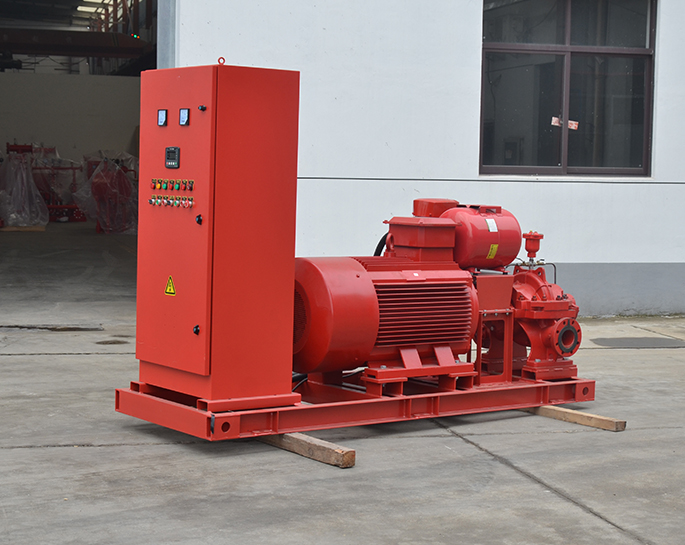What are common issues or failures with electric fire pumps?
Mar 21, 2024
Share:
Electric fire pumps, like any mechanical system, can experience various issues or failures. Some common ones include:
1. **Power Supply Issues**: Interruptions in power supply can render electric fire pumps ineffective. This might be due to electrical grid failures, blown fuses, tripped circuit breakers, or issues with the backup power system.
2. **Motor Failures**: The electric motor that drives the pump can fail due to various reasons such as overheating, bearing wear, insulation breakdown, or electrical faults.
3. **Pump Seal Leaks**: Seals within the pump can degrade over time, leading to leaks. This can result from wear and tear, improper installation, or exposure to corrosive substances.
4. **Clogging or Blockages**: Debris in the water supply or within the pump itself can cause clogging or blockages, reducing or completely obstructing water flow.
5. **Pressure Control Issues**: Malfunctioning pressure control switches or valves can lead to inadequate pressure regulation, potentially resulting in insufficient water flow or excessive pressure, both of which are undesirable in firefighting scenarios.
6. **Control System Failures**: Issues with the control system, such as malfunctioning sensors, relays, or wiring, can impair the pump's operation or prevent it from starting when needed.
7. **Corrosion**: Corrosion of components due to exposure to water, chemicals, or environmental conditions can compromise the integrity and performance of the pump over time.
8. **Vibration and Alignment Problems**: Improper alignment of pump components or excessive vibration during operation can cause mechanical stress, leading to premature wear and failure of parts such as bearings, shafts, and couplings.
9. **Overheating**: Excessive heat buildup within the pump or motor can occur due to factors such as inadequate ventilation, overloading, or prolonged operation under high ambient temperatures, potentially leading to component damage or failure.
10. **Lack of Maintenance**: Neglecting regular maintenance tasks such as lubrication, inspection, and cleaning can exacerbate wear and tear, increase the likelihood of failures, and shorten the pump's lifespan.
Addressing these issues often requires regular inspection, preventive maintenance, prompt repairs, and ensuring proper installation and operation of electric fire pump systems. Additionally, having contingency plans and backup systems in place can help mitigate the impact of potential failures during critical firefighting operations.

1. **Power Supply Issues**: Interruptions in power supply can render electric fire pumps ineffective. This might be due to electrical grid failures, blown fuses, tripped circuit breakers, or issues with the backup power system.
2. **Motor Failures**: The electric motor that drives the pump can fail due to various reasons such as overheating, bearing wear, insulation breakdown, or electrical faults.
3. **Pump Seal Leaks**: Seals within the pump can degrade over time, leading to leaks. This can result from wear and tear, improper installation, or exposure to corrosive substances.
4. **Clogging or Blockages**: Debris in the water supply or within the pump itself can cause clogging or blockages, reducing or completely obstructing water flow.
5. **Pressure Control Issues**: Malfunctioning pressure control switches or valves can lead to inadequate pressure regulation, potentially resulting in insufficient water flow or excessive pressure, both of which are undesirable in firefighting scenarios.
6. **Control System Failures**: Issues with the control system, such as malfunctioning sensors, relays, or wiring, can impair the pump's operation or prevent it from starting when needed.
7. **Corrosion**: Corrosion of components due to exposure to water, chemicals, or environmental conditions can compromise the integrity and performance of the pump over time.
8. **Vibration and Alignment Problems**: Improper alignment of pump components or excessive vibration during operation can cause mechanical stress, leading to premature wear and failure of parts such as bearings, shafts, and couplings.
9. **Overheating**: Excessive heat buildup within the pump or motor can occur due to factors such as inadequate ventilation, overloading, or prolonged operation under high ambient temperatures, potentially leading to component damage or failure.
10. **Lack of Maintenance**: Neglecting regular maintenance tasks such as lubrication, inspection, and cleaning can exacerbate wear and tear, increase the likelihood of failures, and shorten the pump's lifespan.
Addressing these issues often requires regular inspection, preventive maintenance, prompt repairs, and ensuring proper installation and operation of electric fire pump systems. Additionally, having contingency plans and backup systems in place can help mitigate the impact of potential failures during critical firefighting operations.







